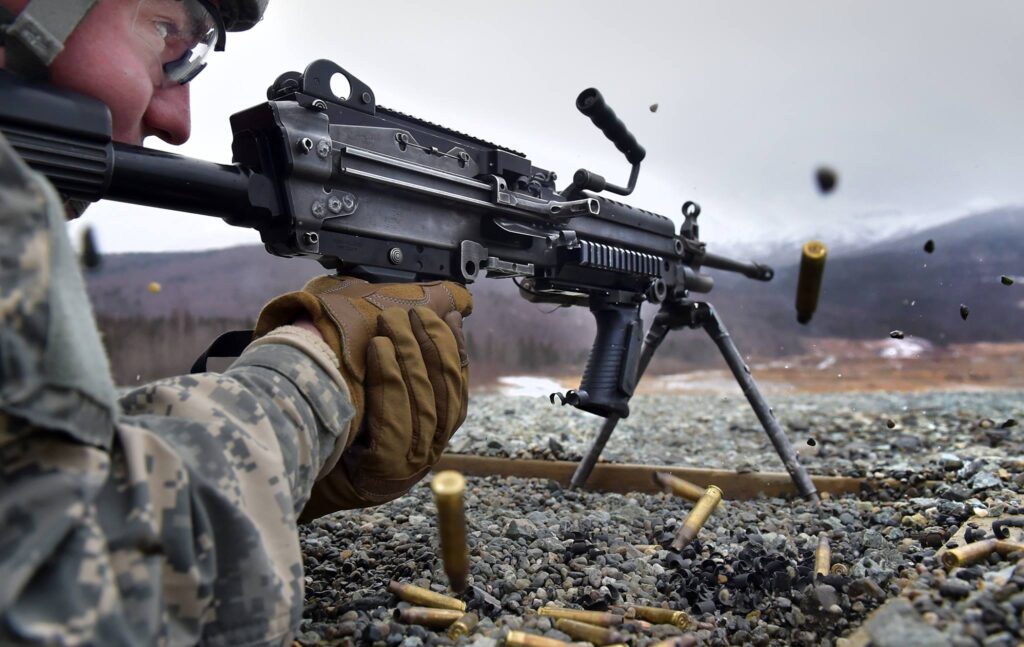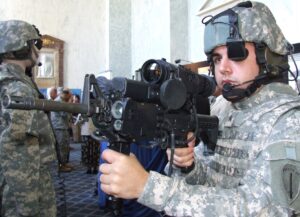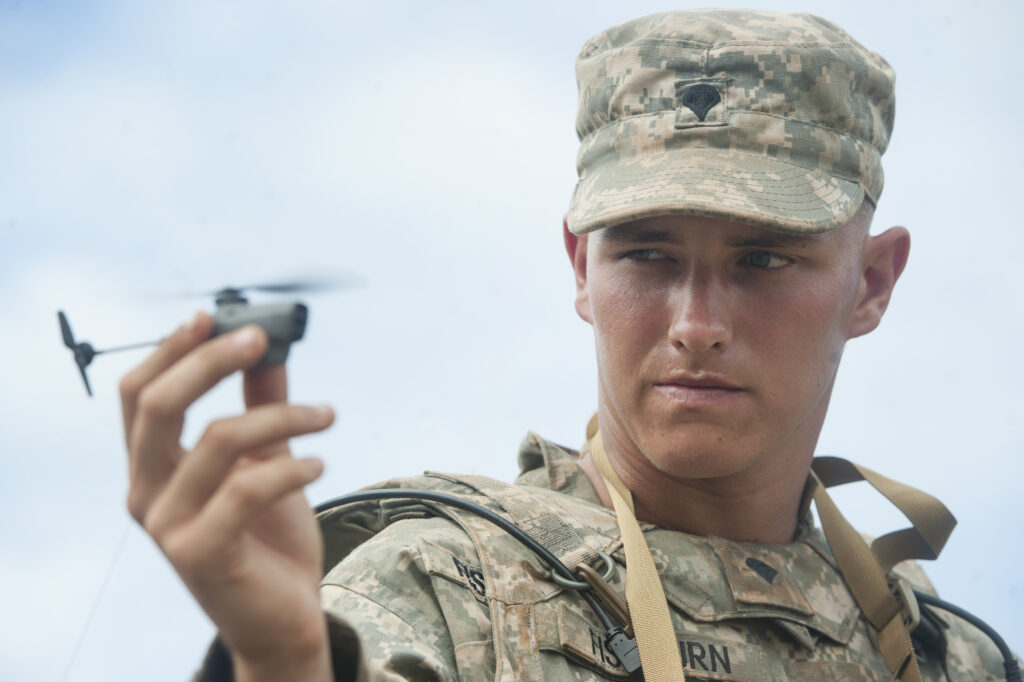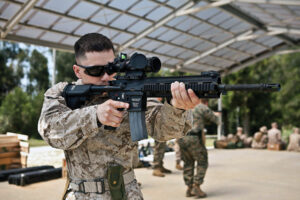By SYDNEY J. FREEDBERG JR.
 There’s a revolution afoot in America’s infantry. New guns to replace the M4 carbine, M16 rifle, and M249 Squad Automatic Weapon. A new mini-drone to scout ahead. A new tactical network to link scattered units. A new night vision sight that displays targeting data like a fighter pilot’s Heads-Up Display. New tactics to use all of the above and new VR simulators to train on. All these innovations could be in the hands of US Army infantry within “a few years,” Brig. Gen. Christopher Donahue told reporters Friday.
There’s a revolution afoot in America’s infantry. New guns to replace the M4 carbine, M16 rifle, and M249 Squad Automatic Weapon. A new mini-drone to scout ahead. A new tactical network to link scattered units. A new night vision sight that displays targeting data like a fighter pilot’s Heads-Up Display. New tactics to use all of the above and new VR simulators to train on. All these innovations could be in the hands of US Army infantry within “a few years,” Brig. Gen. Christopher Donahue told reporters Friday.
The catch, of course, is that the Army’s tried to field all these things before — and failed. Why would things go any better this time around?
First, the technology’s gotten better. This stuff is real, Donahue said. “We’ve already seen and touched a number” of potential Squad Automatic Weapons (basically a heavy assault rifle or light machinegun), Donahue said. “We’ll be getting our first prototypes here in about a year.”
Army troops have field-tested palm-top mini-drones, notably in the PACMAN exercises in Hawaii, and the Defense Secretary’s Close Combat Lethality Task Force is funding procurement for the Army. Special Operations Forces are already using an early version of network devices. And the new night vision sight can be issued to combat units “in six to seven months.”
That brings us to the second big difference: speed. Last fall, Army Chief of Staff Mark Milley created eight Cross Functional Teams to accelerate modernization by bringing together experts from across the bureaucracy, led by one- and two-star combat veterans with the clout to push things through. This spring, Defense Secretary Jim Mattis created his own high-level, high-speed team, the Close Combat Lethality Task Force, specifically to improve the infantry.
The Army’s high-tech but cumbersome Land Warrior kit, subsequently cancelled.
Brig. Gen. Donahue has three jobs: He sits on the Secretary’s inter-service task force, he leads the Army’s Soldier Lethality Cross Functional Team, and he commands the Infantry School at Fort Benning. Each CFT is different, he said. “Ours is definitely the most broad as far as what we have a mandate to do,” he explained: not just new equipment — his focus in today’s interview — but also training and human performance.
 In another sense, however, the Soldier Lethality team is tightly focused. Unlike past programs, they are not trying to come up with General Issue gear for a million GIs. Instead, “we’re focused on the 100,000 active, National Guard, and…Reserve that actually close with the enemy,” he said: infantry, scouts, armored vehicle crews, plus some frontline specialists such as forward observers (who call in artillery and airstrikes) and medics. “We call that the close combat 100,000.”
In another sense, however, the Soldier Lethality team is tightly focused. Unlike past programs, they are not trying to come up with General Issue gear for a million GIs. Instead, “we’re focused on the 100,000 active, National Guard, and…Reserve that actually close with the enemy,” he said: infantry, scouts, armored vehicle crews, plus some frontline specialists such as forward observers (who call in artillery and airstrikes) and medics. “We call that the close combat 100,000.”
By focusing on 100,000 soldiers out of a million-strong Army (active, reserve, and Guard), the Soldier Lethality task force cuts both the time and cost to field its innovations by about 90 percent.

A soldier holds a PD-100 mini-drone during the PACMAN-I experiment in Hawaii.
Going Fast
The Cross Functional Teams just stood up in November but they’ve crammed years of work into the last five months. Donahue’s CFT quickly identified new night vision devices as low-hanging fruit and put together a formal requirement for them — a process that normally takes years — “in about five weeks,” he said. They’ve also done three “test points” with soldiers using the equipment. “Once the budget’s passed and we have the money,” he said, they can get the sights to Army troops — and potentially Marines and special operators, who are also very interested — in “six to seven months.”
The Army Nett Warrior system uses Android phones to link to the tactical network, but soldiers have to take their eyes off the target to use it.
While the device is called Enhanced Night Vision Goggles – Binocular (ENVG-B), it’s much more than a night sight. Yes, it combines light amplification with infrared in a dual-camera setup (hence “binocular”) that provides depth perception, a major improvement to aiming at night. But it also has an augmented reality display that Donahue considers the first step towards giving foot troops the kind of computerized Heads-Up Display (HUD) used by fighter pilots.
For example, soldiers can link the goggles to their weapon, then turn on a targeting reticle (i.e. cross-hairs), superimposed over their field of view to show exactly where their shot will land. “What we’re seeing in the initial testing is they’re shooting significantly better,” he said.
Soldiers can also link the goggles to their wireless networking device, which automatically shares tactical data across the force. Instead of looking down at a compass, map, or a handheld GPS — which takes their eyes off the target — they can see their heading superimposed on their view of the real world. The goggles can even display tactical data from the network, for example a red dot to indicate an enemy’s been spotted in a specific direction.
Donahue’s Cross Functional Team is working closely with the network CFT, led by Maj. Gen. Pete Gallagher, to get all this to work in combat. Donahue’s CFT is also working with Maj. Gen. Maria Gervais’s Synthetic Training Environment CFT on how to load training scenarios into the goggles so they allow troops to train with virtual obstacles and enemies. (It’d be a bit like a militarized version of Pokémon Go).
Overall, said Donahue, everything the squad carries will have to be compatible with an Adaptive Soldier Architecture. The goal is set of common standards that will allow the Army to field new updates quickly, rather than laboriously kludging together pieces of kit that were never designed to be compatible.
A Marine checks out the M27 Infantry Automatic Rifle (IAR)
 Donahue also has a Lethality Analysis Team conducting a rigorous study of every piece of equipment issued to the infantry. “If you put something onto an F-35 or an M1 tank, you know exactly what that does,” he said. “We don’t have that same data of what happens if you put something into a squad.” Donahue wants every piece of kit examined to reduce weight, reduce power demands — batteries are a major burden in the field — and to increase combat power.
Donahue also has a Lethality Analysis Team conducting a rigorous study of every piece of equipment issued to the infantry. “If you put something onto an F-35 or an M1 tank, you know exactly what that does,” he said. “We don’t have that same data of what happens if you put something into a squad.” Donahue wants every piece of kit examined to reduce weight, reduce power demands — batteries are a major burden in the field — and to increase combat power.
That includes new weapons. The Marine Corps already replaced some of their M249 Squad Automatic Weapons (SAW) with the much lighter M27 Infantry Automatic Rifle (IAR), going from 23 pounds to nine and improving accuracy, albeit at the price of halving the rate of fire. Currently, the Marines are replacing all their M16 rifles and M4 carbines with M27. The Army is set to follow suit, albeit not necessarily with the same weapon. The service’s Next Generation Squad Weapon, originally meant to replace the M249 alone, will now also evolve into a replacement for the M4 and M16.
That second-stage weapon, the carbine replacement, will have to be significantly lighter than the M249 SAW replacement, Donahue said. (He consistently said “carbine” today, not “rifle,” which probably rules out the Marines’ M27 as too heavy). The technology to get all the desired capabilities in a lighter package is “not right there yet,” he said.
But the Army’s not looking at a long development program. Army Secretary Mark Esper recently promised the Squad Automatic Weapon replacement by 2023. As for the carbine, Donahue said, “you’ll see it a couple years after the replacement of the SAW.”
No comments:
Post a Comment